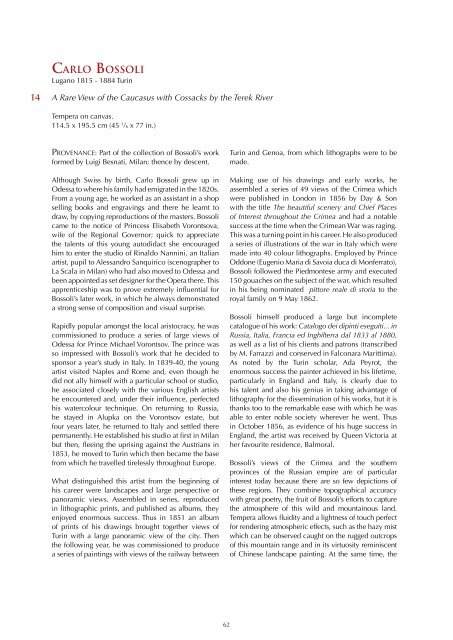Create successful ePaper yourself
Turn your PDF publications into a flip-book with our unique Google optimized e-Paper software.
Carlo Bossoli<br />
Lugano 1815 - 1884 Turin<br />
14<br />
A Rare View of the Caucasus with Cossacks by the Terek River<br />
Tempera on canvas.<br />
114.5 x 195.5 cm (45 1 /6 x 77 in.)<br />
Provenance: Part of the collection of Bossoli’s work<br />
formed by Luigi Besnati, Milan; thence by descent.<br />
Although Swiss by birth, Carlo Bossoli grew up in<br />
Odessa to where his family had emigrated in the 1820s.<br />
From a young age, he worked as an assistant in a shop<br />
selling books and engravings and there he learnt to<br />
draw, by copying reproductions of the masters. Bossoli<br />
came to the notice of Princess Elisabeth Vorontsova,<br />
wife of the Regional Governor; quick to appreciate<br />
the talents of this young autodidact she encouraged<br />
him to enter the studio of Rinaldo Nannini, an Italian<br />
artist, pupil to Alessandro Sanquirico (scenographer to<br />
La Scala in Milan) who had also moved to Odessa and<br />
been appointed as set designer for the Opera there. This<br />
apprenticeship was to prove extremely influential for<br />
Bossoli’s later work, in which he always demonstrated<br />
a strong sense of composition and visual surprise.<br />
Rapidly popular amongst the local aristocracy, he was<br />
commissioned to produce a series of large views of<br />
Odessa for Prince Michael Vorontsov. The prince was<br />
so impressed with Bossoli’s work that he decided to<br />
sponsor a year’s study in Italy. In 1839-40, the young<br />
artist visited Naples and Rome and, even though he<br />
did not ally himself with a particular school or studio,<br />
he associated closely with the various English artists<br />
he encountered and, under their influence, perfected<br />
his watercolour technique. On returning to Russia,<br />
he stayed in Alupka on the Vorontsov estate, but<br />
four years later, he returned to Italy and settled there<br />
permanently. He established his studio at first in Milan<br />
but then, fleeing the uprising against the Austrians in<br />
1853, he moved to Turin which then became the base<br />
from which he travelled tirelessly throughout Europe.<br />
What distinguished this artist from the beginning of<br />
his career were landscapes and large perspective or<br />
panoramic views. Assembled in series, reproduced<br />
in lithographic prints, and published as albums, they<br />
enjoyed enormous success. Thus in 1851 an album<br />
of prints of his drawings brought together views of<br />
Turin with a large panoramic view of the city. Then<br />
the following year, he was commissioned to produce<br />
a series of paintings with views of the railway between<br />
Turin and Genoa, from which lithographs were to be<br />
made.<br />
Making use of his drawings and early works, he<br />
assembled a series of 49 views of the Crimea which<br />
were published in London in 1856 by Day & Son<br />
with the title The beautiful scenery and Chief Places<br />
of Interest throughout the Crimea and had a notable<br />
success at the time when the Crimean War was raging.<br />
This was a turning point in his career. He also produced<br />
a series of illustrations of the war in Italy which were<br />
made into 40 colour lithographs. Employed by Prince<br />
Oddone (Eugenio Maria di Savoia duca di Monferrato),<br />
Bossoli followed the Piedmontese army and executed<br />
150 gouaches on the subject of the war, which resulted<br />
in his being nominated pittore reale di storia to the<br />
royal family on 9 May 1862.<br />
Bossoli himself produced a large but incomplete<br />
catalogue of his work: Catalogo dei dipinti eseguiti... in<br />
Russia, Italia, Francia ed Inghilterra dal 1833 al 1880,<br />
as well as a list of his clients and patrons (transcribed<br />
by M. Farrazzi and conserved in Falconara Marittima).<br />
As noted by the Turin scholar, Ada Peyrot, the<br />
enormous success the painter achieved in his lifetime,<br />
particularly in England and Italy, is clearly due to<br />
his talent and also his genius in taking advantage of<br />
lithography for the dissemination of his works, but it is<br />
thanks too to the remarkable ease with which he was<br />
able to enter noble society wherever he went. Thus<br />
in October 1856, as evidence of his huge success in<br />
England, the artist was received by Queen Victoria at<br />
her favourite residence, Balmoral.<br />
Bossoli’s views of the Crimea and the southern<br />
provinces of the Russian empire are of particular<br />
interest today because there are so few depictions of<br />
these regions. They combine topographical accuracy<br />
with great poetry, the fruit of Bossoli’s efforts to capture<br />
the atmosphere of this wild and mountainous land.<br />
Tempera allows fluidity and a lightness of touch perfect<br />
for rendering atmospheric effects, such as the hazy mist<br />
which can be observed caught on the rugged outcrops<br />
of this mountain range and in its virtuosity reminiscent<br />
of Chinese landscape painting. At the same time, the<br />
62
















